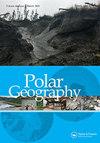东北亚二十年活动层厚监测
IF 1.6
Q3 GEOGRAPHY, PHYSICAL
引用次数: 30
摘要
摘要:本研究总结了1995-2018年东北亚不同永久冻土区的季节性融化数据。在环极活动层监测(CALM)项目下,在雅纳-英迪吉卡和科雷马低地以及楚科奇半岛的多年冻土景观的一系列地点进行了经验观测,并辅以堪察加半岛火山山区10年的观测。在解冻季节结束时使用机械探测进行的解冻深度观测和地面温度测量,分析了空气温度趋势。来自24个站点(16个在印第吉尔卡-科雷马地区,5个在楚科奇,3个在堪察加)的数据揭示了活动层厚度(ALT)对近期大气气候变化的不同反应。总体上,ALT与夏季气温呈正相关。自2000年代初以来,Kolyma和Chukotka地区的气温均呈现正异常(与所有站点的平均数据相比),只有一个站点的气温呈现负异常趋势。堪察加山脉唯一的活动地点在观测期间没有明显的融化深度变化。堪察加半岛的另外两个地方也在2012年的火山爆发中受到影响。本文章由计算机程序翻译,如有差异,请以英文原文为准。
Two decades of active layer thickness monitoring in northeastern Asia
ABSTRACT This study summarizes seasonal thawing data collected in different permafrost regions of northeast Asia over the 1995–2018 period. Empirical observations were undertaken under the Circumpolar Active Layer Monitoring (CALM) program at a range of sites across the permafrost landscapes of the Yana-Indigirka and Kolyma lowlands and the Chukotka Peninsula, and supplemented with 10 years of observations from volcanic mountainous areas of the Kamchatka Peninsula. Thaw depth observations, taken using mechanical probing at the end of the thawing season, and ground temperature measurements, were analyzed with respect to air temperatures trends. The data from 24 sites (16 in the Indigirka-Kolyma region, 5 in Chukotka and 3 in Kamchatka) reveal different reactions of the active layer thickness (ALT) to recent changes in atmospheric climate. In general, there is a positive relation between ALT and summer air temperatures. Since the early 2000s positive ALT anomalies (compared with mean data from all sites) prevail in the Kolyma and Chukotka area, with only one alas site showing a negative ALT trend. The only active site in the Kamchatka Mountains shows no significant thaw depth changes over the period of observation. Two other Kamchatka sites were affected during a volcanic eruption in 2012.
求助全文
通过发布文献求助,成功后即可免费获取论文全文。
去求助
来源期刊

Polar Geography
GEOGRAPHY, PHYSICAL-
CiteScore
5.30
自引率
0.00%
发文量
13
期刊介绍:
Polar Geographyis a quarterly publication that offers a venue for scholarly research on the physical and human aspects of the Polar Regions. The journal seeks to address the component interplay of the natural systems, the complex historical, political, economic, cultural, diplomatic, and security issues, and the interchange amongst them. As such, the journal welcomes comparative approaches, critical scholarship, and alternative and disparate perspectives from around the globe. The journal offers scientists a venue for publishing longer papers such as might result from distillation of a thesis, or review papers that place in global context results from coordinated national and international efforts currently underway in both Polar Regions.
 求助内容:
求助内容: 应助结果提醒方式:
应助结果提醒方式:


